Enhanced Transdermal Delivery via Electrospun PMMA Fiber Mats Incorporating Ibuprofen-Intercalated Layered Double Hydroxides
Abstract
1. Introduction
2. Materials and Methods
2.1. Materials and Chemicals
2.2. Equipment
2.3. Experiment
2.3.1. Synthesis of LDH–IBU
2.3.2. Preparation of Spinning Solution
2.3.3. Electrospinning Procedure
2.3.4. Drug Release Experiment
2.3.5. Artificial Skin Permeation Experiment
3. Results and Discussion
4. Conclusions
Supplementary Materials
Author Contributions
Funding
Data Availability Statement
Conflicts of Interest
References
- Adepu, S.; Ramakrishna, S. Controlled Drug Delivery Systems: Current Status and Future Directions. Molecules 2021, 26, 5905. [Google Scholar] [CrossRef] [PubMed]
- Jamrozy, M.; Kudlacik-Kramarczyk, S.; Drabczyk, A.; Krzan, M. Advanced Drug Carriers: A Review of Selected Protein, Polysaccharide, and Lipid Drug Delivery Platforms. Int. J. Mol. Sci. 2024, 25, 786. [Google Scholar] [CrossRef]
- Sanjivani, A.C.; Vikas, K.G.; Shivshankar, D.M.; Rutuja, G.W.; Tejas, J.S. Transdermal Drug Delivery System: A Review of Current Advances and Challenges. J. Ayurveda Integr. Med. Sci. 2025, 9, 203–212. [Google Scholar] [CrossRef]
- Alkilani, A.Z.; Nasereddin, J.; Hamed, R.; Nimrawi, S.; Hussein, G.; Abo-Zour, H.; Donnelly, R.F. Beneath the Skin: A Review of Current Trends and Future Prospects of Transdermal Drug Delivery Systems. Pharmaceutics 2022, 14, 1152. [Google Scholar] [CrossRef]
- Shankhapal, S.; Pandav, V.; Jaiswal, R.; Kalam, S. Transdermal Drug Delivery System. Int. J. Pharm. Sci. 2024, 2, 3570–3580. [Google Scholar]
- Tai, F.W.D.; McAlindon, M.E. Non-steroidal anti-inflammatory drugs and the gastrointestinal tract. Clin. Med. 2021, 21, 131–134. [Google Scholar] [CrossRef] [PubMed]
- Bushra, R.; Aslam, N. An overview of clinical pharmacology of Ibuprofen. Oman Med. J. 2010, 25, 155–1661. [Google Scholar] [CrossRef]
- Elsie, E.; Gaskell, T.H.; Hamilton, A.R. Ibuprofen intercalation and release from different layered double hydroxides. Ther. Deliv. 2018, 9, 653–666. [Google Scholar] [CrossRef]
- Bi, X.; Zhang, H.; Dou, L. Layered double hydroxide-based nanocarriers for drug delivery. Pharmaceutics 2014, 6, 298–332. [Google Scholar] [CrossRef] [PubMed]
- Pavlovic, M.; Szerlauth, A.; Murath, S.; Varga, G.; Szilagyi, I. Surface modification of two-dimensional layered double hydroxide nanoparticles with biopolymers for biomedical applications. Adv. Drug Deliv. Rev. 2022, 191, 114590. [Google Scholar] [CrossRef]
- Arrabito, G.; Pezzilli, R.; Prestopino, G.; Medaglia, P.G. Layered Double Hydroxides in Bioinspired Nanotechnology. Crystals 2020, 10, 602. [Google Scholar] [CrossRef]
- Rives, V.; del Arco, M.; Martín, C. Intercalation of drugs in layered double hydroxides and their controlled release: A review. Appl. Clay Sci. 2014, 88–89, 239–269. [Google Scholar] [CrossRef]
- Wang, C.; Su, Y.; Xie, J. Advances in Electrospun Nanofibers: Versatile Materials and Diverse Biomedical Applications. Acc. Mater. Res. 2024, 5, 987–999. [Google Scholar] [CrossRef]
- Franco, R.F.; Jimenez, P.C. Pharmacological Applications of Electrospun Nanofibers Loaded with Bioactive Natural Compounds and Extracts: A Systematic Review. Drugs Drug Candidates 2025, 4, 8. [Google Scholar] [CrossRef]
- Celebioglu, A.; Uyar, T. Fast Dissolving Oral Drug Delivery System Based on Electrospun Nanofibrous Webs of Cyclodextrin/Ibuprofen Inclusion Complex Nanofibers. Mol. Pharm. 2019, 16, 4387–4398. [Google Scholar] [CrossRef] [PubMed]
- Ma, Q.; Liu, J.; Tang, R.; Liu, Z.; Wu, J. Chitosan and ibuprofen functionalized electrospun nanofiber membrane modulates inflammatory response and promotes full-thickness abdominal wall repair. Int. J. Biol. Macromol. 2025, 321, 146380. [Google Scholar] [CrossRef]
- Bai, Y.; Wang, D.; Zhang, Z.; Pan, J.; Cui, Z.; Yu, D.-G.; Annie Bligh, S.-W. Testing of fast dissolution of ibuprofen from its electrospun hydrophilic polymer nanocomposites. Polym. Test. 2021, 93, 106872. [Google Scholar] [CrossRef]
- Immich, A.P.; Arias, M.L.; Carreras, N.; Boemo, R.L.; Tornero, J.A. Drug delivery systems using sandwich configurations of electrospun poly(lactic acid) nanofiber membranes and ibuprofen. Mater. Sci. Eng. C Mater. Biol. Appl. 2013, 33, 4002–4008. [Google Scholar] [CrossRef] [PubMed]
- Riggin, C.N.; Qu, F.; Kim, D.H.; Huegel, J.; Steinberg, D.R.; Kuntz, A.F.; Soslowsky, L.J.; Mauck, R.L.; Bernstein, J. Electrospun PLGA Nanofiber Scaffolds Release Ibuprofen Faster and Degrade Slower After In Vivo Implantation. Ann. Biomed. Eng. 2017, 45, 2348–2359. [Google Scholar] [CrossRef]
- Bae, H.-S.; Haider, A.; Selim, K.M.K.; Kang, D.-Y.; Kim, E.-J.; Kang, I.-K. Fabrication of highly porous PMMA electrospun fibers and their application in the removal of phenol and iodine. J. Polym. Res. 2013, 20, 158. [Google Scholar] [CrossRef]
- Abdulhussain, R.; Adebisi, A.; Conway, B.R.; Asare-Addo, K. Electrospun nanofibers: Exploring process parameters, polymer selection, and recent applications in pharmaceuticals and drug delivery. J. Drug Deliv. Sci. Technol. 2023, 90, 105156. [Google Scholar] [CrossRef]
- Philip, P.; Tomlal Jose, E.; Chacko, J.K.; Philip, K.C.; Thomas, P.C. Preparation and characterisation of surface roughened PMMA electrospun nanofibers from PEO-PMMA polymer blend nanofibers. Polym. Test. 2019, 74, 257–265. [Google Scholar] [CrossRef]
- Sivakumar, M.; Rao, K.P. Synthesis and characterization of poly(methyl methacrylate) functional microspheres. React. Funct. Polym. 2000, 46, 29–37. [Google Scholar] [CrossRef]
- Cardinale, A.M.; Carbone, C.; Molinari, S.; Salviulo, G.; Ardini, F. MgAl-NO3 LDH: Adsorption Isotherms and Multivariate Optimization for Cr(VI) Removal. Chemistry 2023, 5, 633–645. [Google Scholar] [CrossRef]
- Yamin, M.; Ghouri, Z.K.; Rohman, N.; Syed, J.A.; Skelton, A.; Ahmed, K. Unravelling pH/pKa influence on pH-responsive drug carriers: Insights from ibuprofen-silica interactions and comparative analysis with carbon nanotubes, sulfasalazine, and alendronate. J. Mol. Graph. Model. 2024, 128, 108720. [Google Scholar] [CrossRef] [PubMed]
- Wang, X.; Wang, Q.; Huang, F.; Wei, Q. The morphology of Taylor cone influenced by different coaxial composite nozzle structures. Fibers Polym. 2016, 17, 624–629. [Google Scholar] [CrossRef]
- Gabbard, C.T.; Bostwick, J.B. Scaling analysis of the Plateau–Rayleigh instability in thin film flow down a fiber. Exp. Fluids 2021, 62, 141. [Google Scholar] [CrossRef]
- Li, L.; Jiang, Z.; Li, M.; Li, R.; Fang, T. Hierarchically structured PMMA fibers fabricated by electrospinning. RSC Adv. 2014, 4, 52973–52985. [Google Scholar] [CrossRef]
- Ma, M.; Sun, R.; Kang, H.; Wang, S.; Jia, P.; Song, Y.; Sun, J. Direct writing concave structure on viscoelastic substrate for loading and releasing liquid on skin surface. Colloids Surf. B. Biointerfaces 2023, 231, 113571. [Google Scholar] [CrossRef] [PubMed]
- Shi, Y.; Wei, Z.; Zhao, H.; Liu, T.; Dong, A.; Zhang, J. Electrospinning of Ibuprofen-Loaded Composite Nanofibers for Improving the Performances of Transdermal Patches. J. Nanosci. Nanotechnol. 2013, 13, 3855–3863. [Google Scholar] [CrossRef]
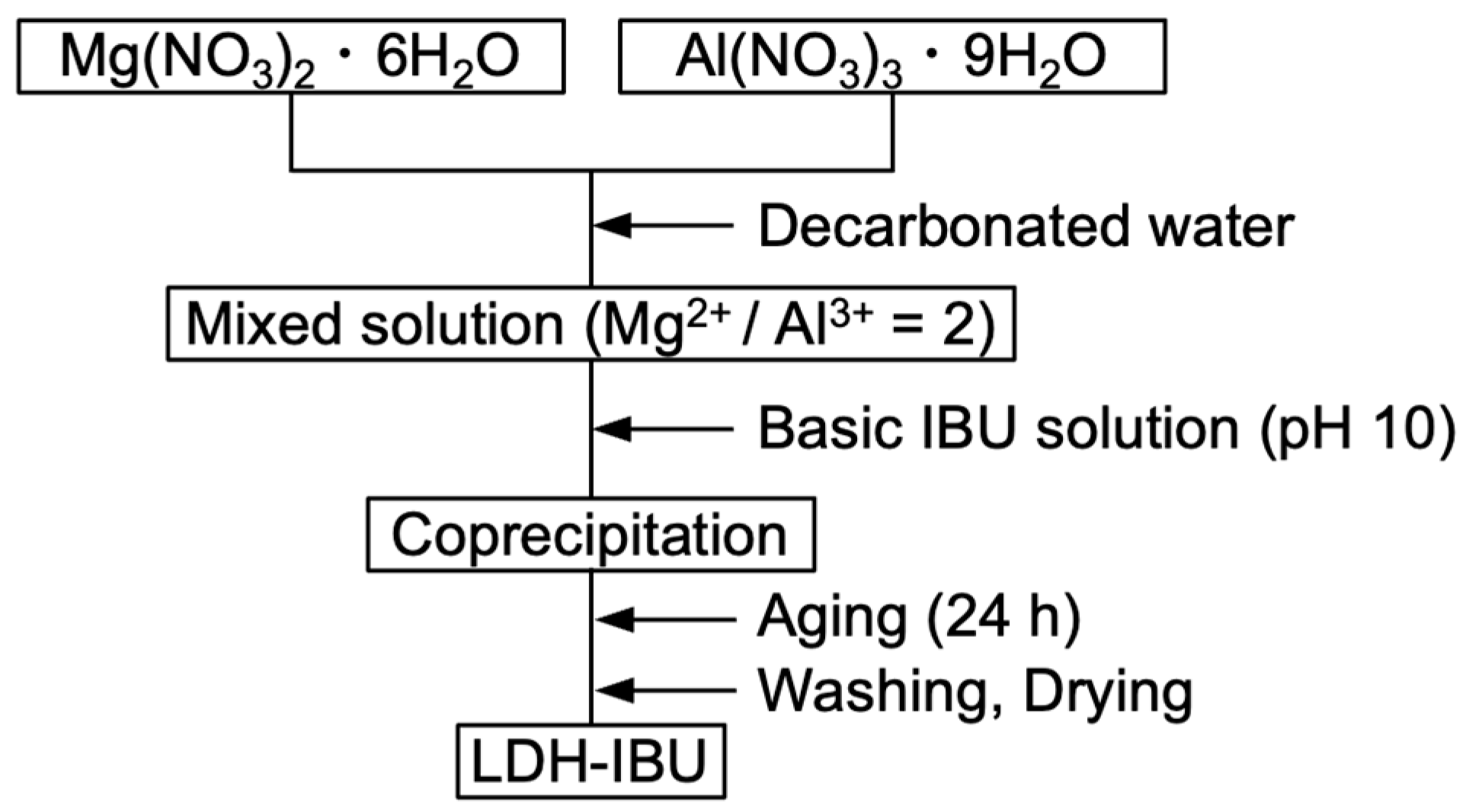
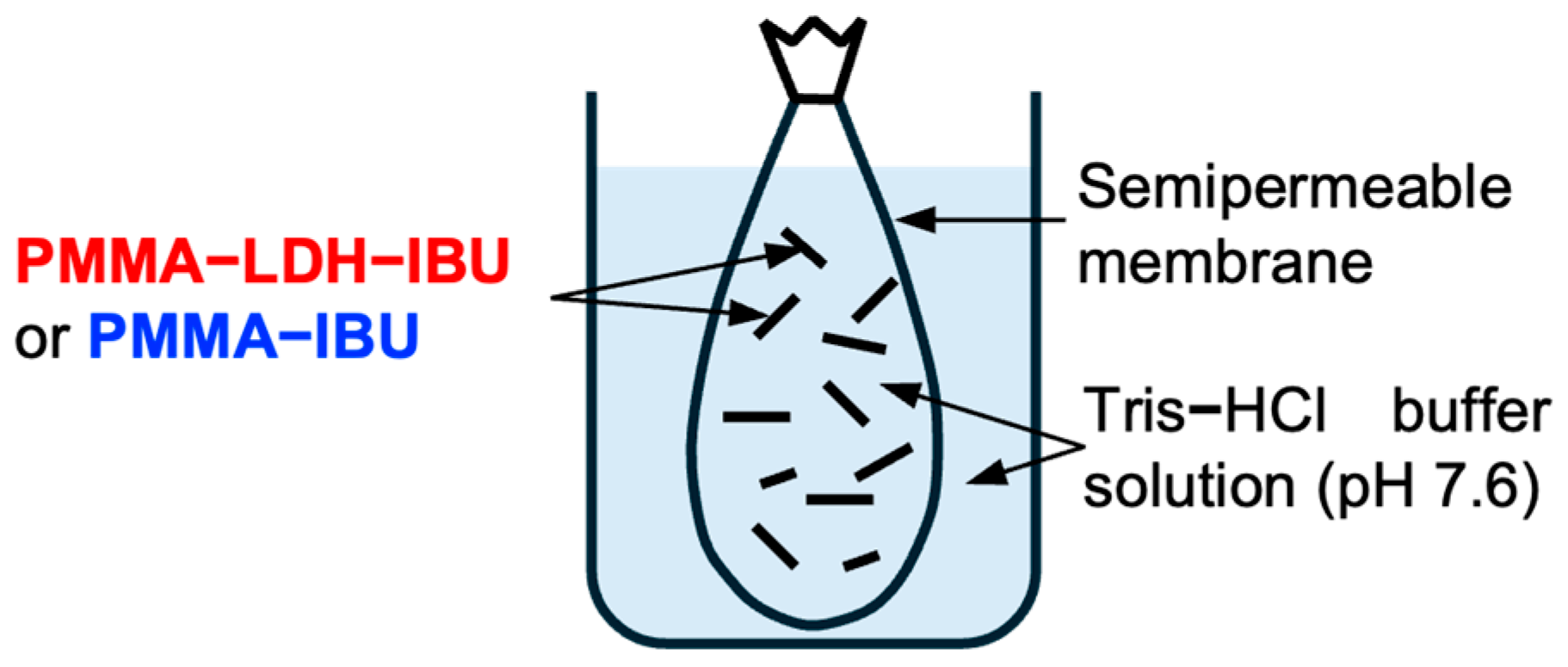
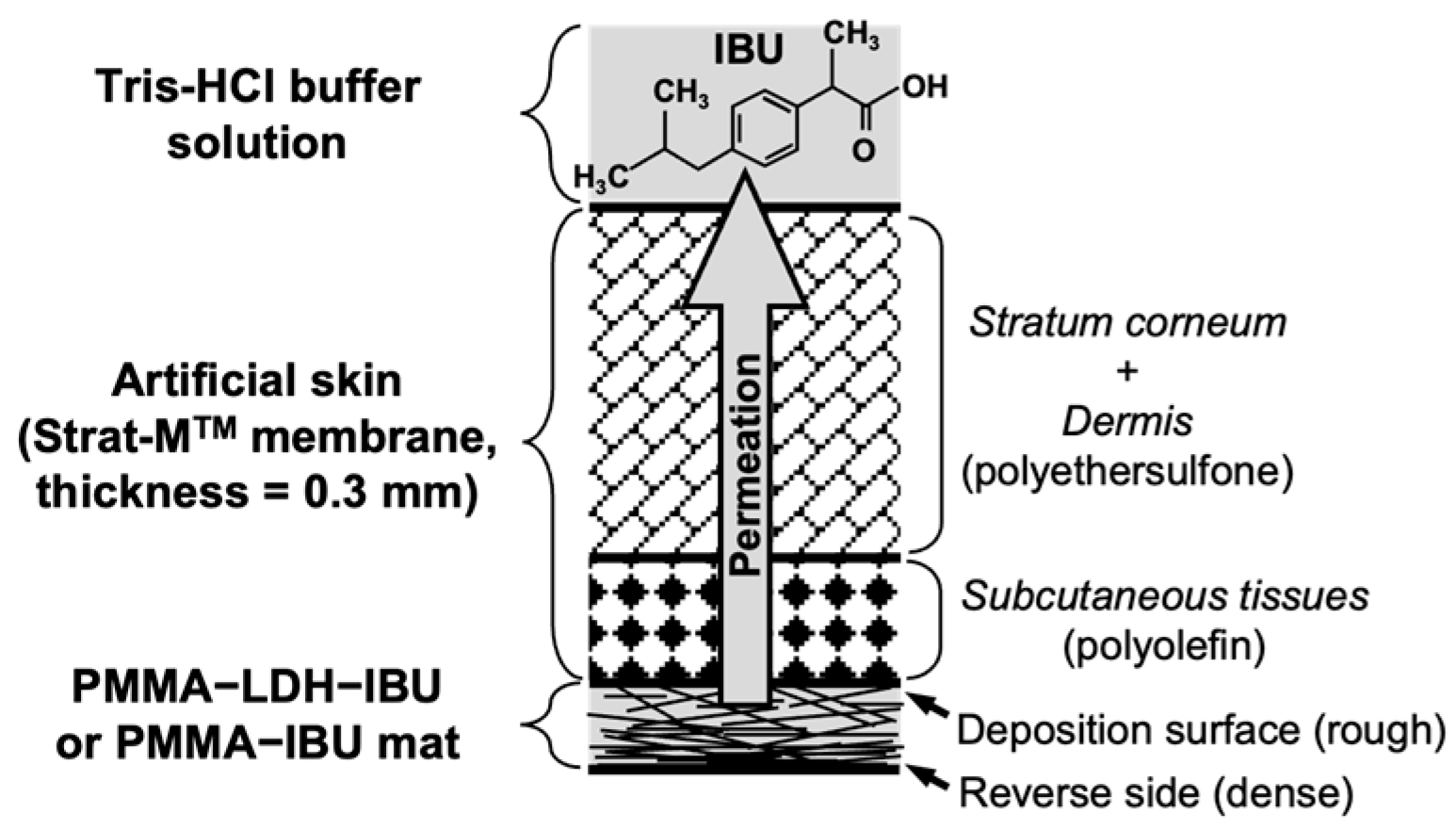
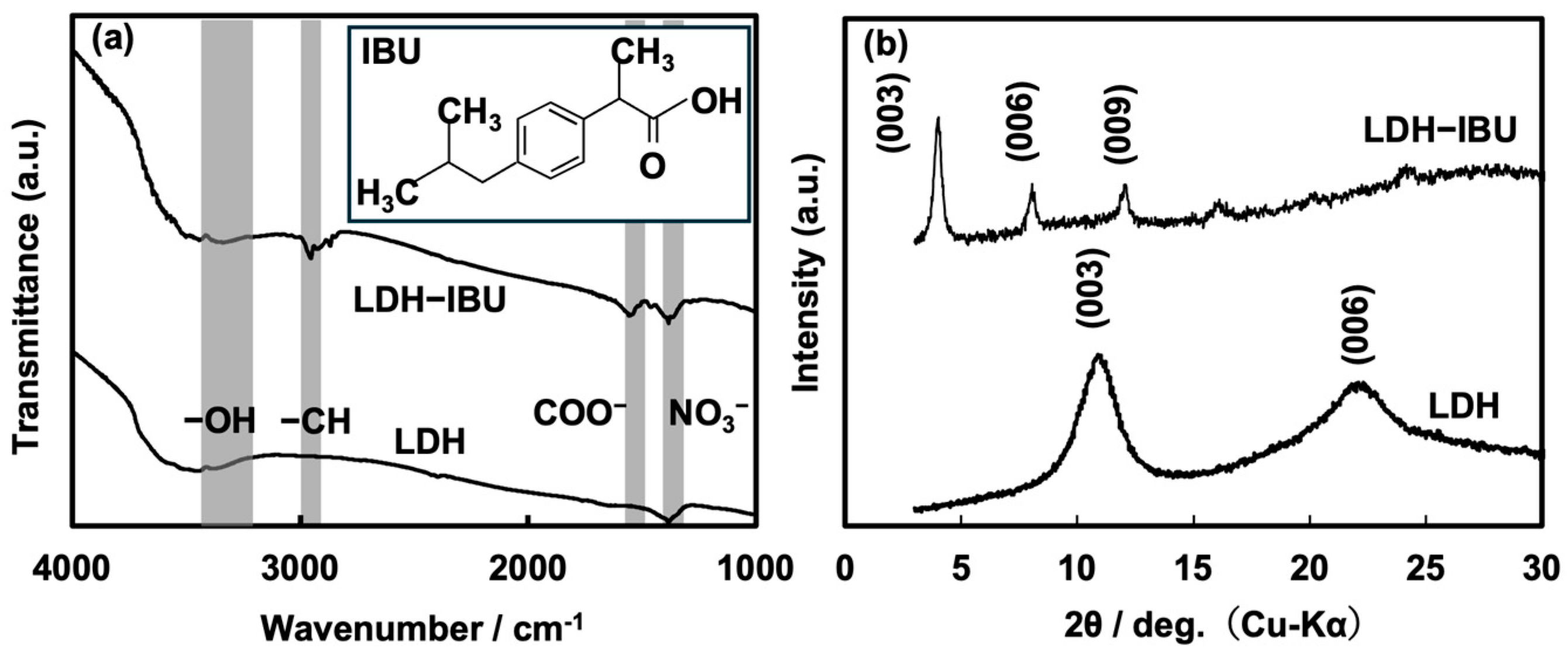

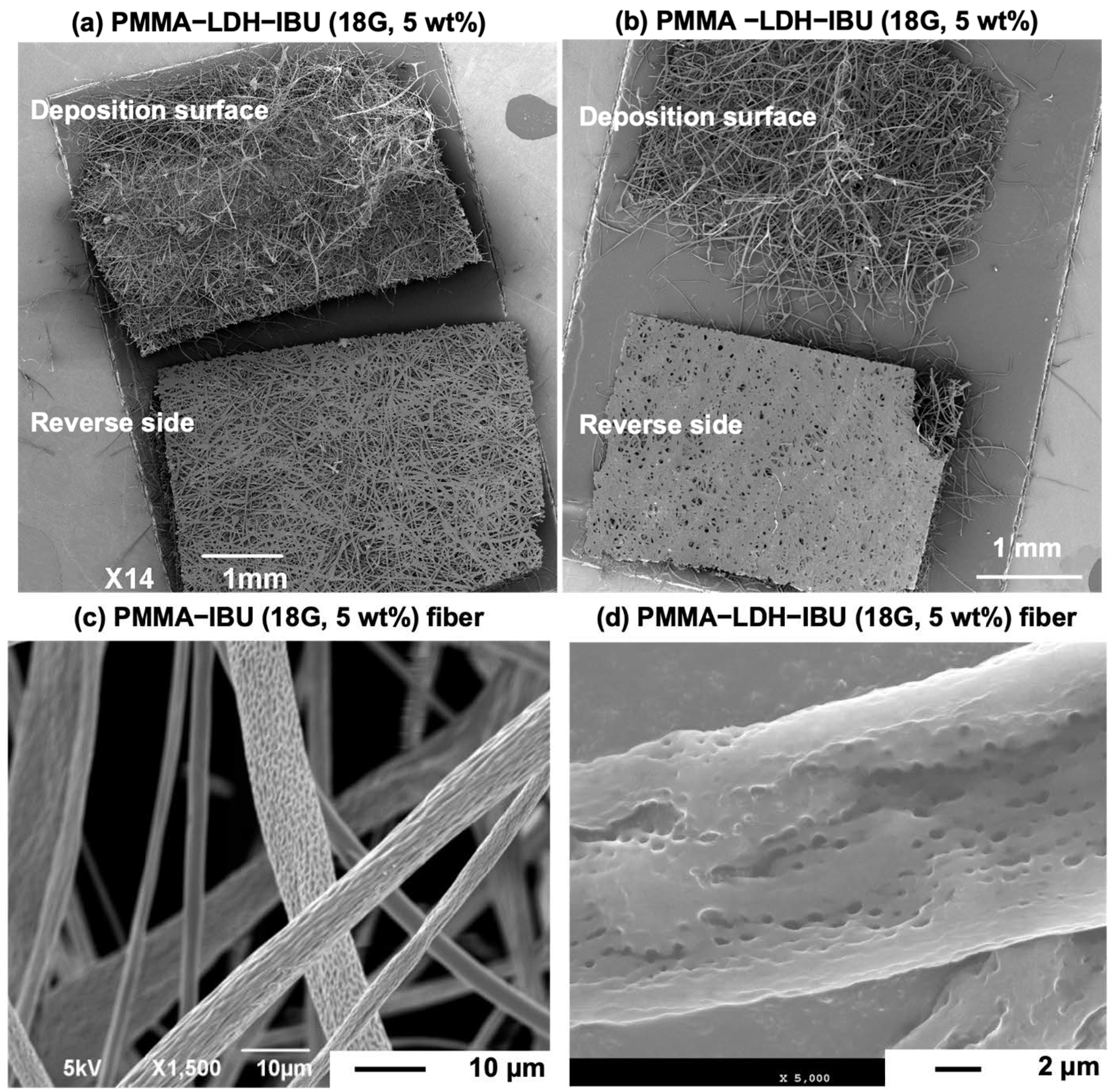

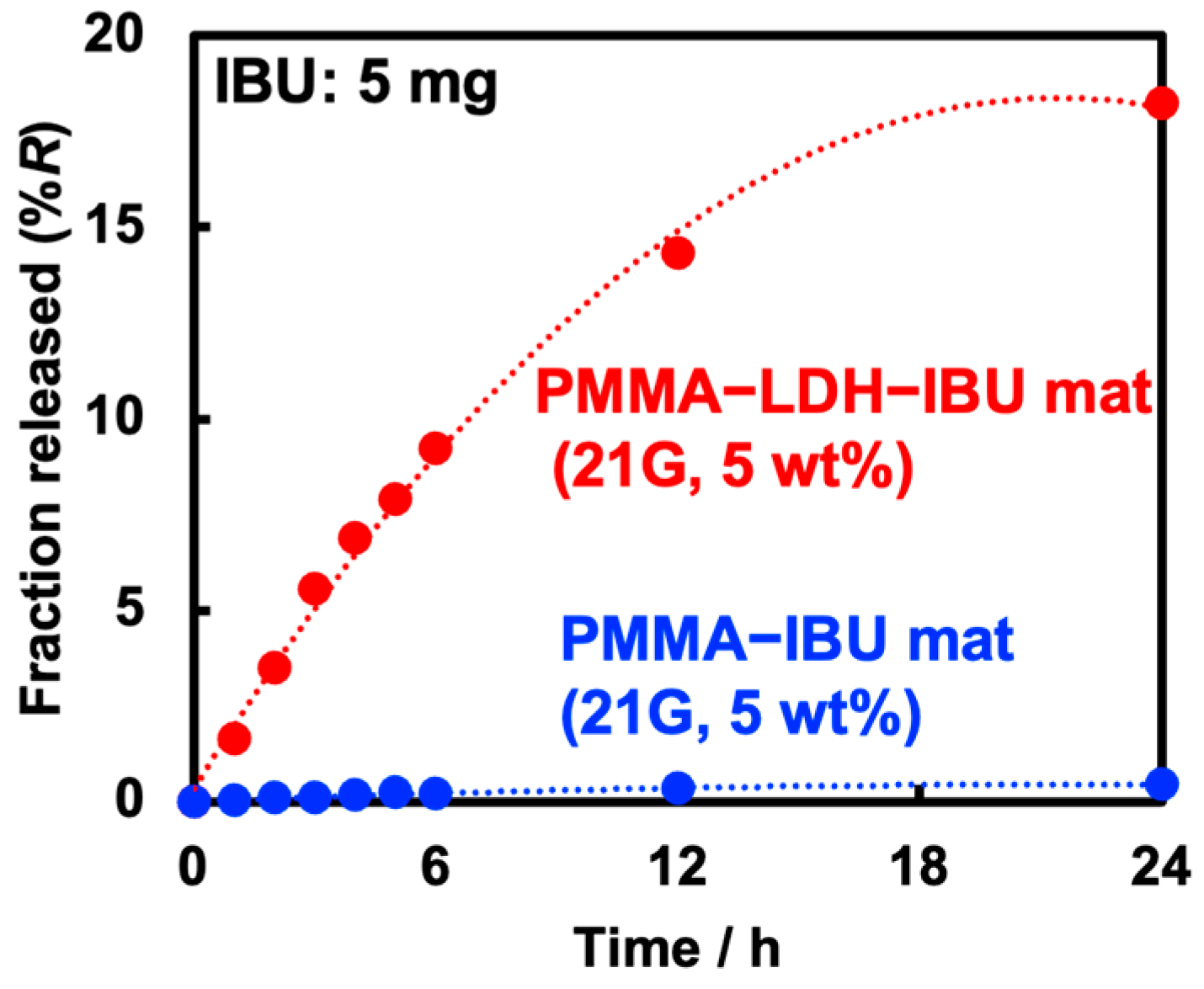
Disclaimer/Publisher’s Note: The statements, opinions and data contained in all publications are solely those of the individual author(s) and contributor(s) and not of MDPI and/or the editor(s). MDPI and/or the editor(s) disclaim responsibility for any injury to people or property resulting from any ideas, methods, instructions or products referred to in the content. |
© 2025 by the authors. Licensee MDPI, Basel, Switzerland. This article is an open access article distributed under the terms and conditions of the Creative Commons Attribution (CC BY) license (https://creativecommons.org/licenses/by/4.0/).
Share and Cite
Tran, V.T.T.; Yamashita, S.; Sano, H.; Nakagoe, O.; Tanabe, S.; Kamada, K. Enhanced Transdermal Delivery via Electrospun PMMA Fiber Mats Incorporating Ibuprofen-Intercalated Layered Double Hydroxides. Ceramics 2025, 8, 124. https://doi.org/10.3390/ceramics8040124
Tran VTT, Yamashita S, Sano H, Nakagoe O, Tanabe S, Kamada K. Enhanced Transdermal Delivery via Electrospun PMMA Fiber Mats Incorporating Ibuprofen-Intercalated Layered Double Hydroxides. Ceramics. 2025; 8(4):124. https://doi.org/10.3390/ceramics8040124
Chicago/Turabian StyleTran, Van Thi Thanh, Shusei Yamashita, Hideaki Sano, Osamu Nakagoe, Shuji Tanabe, and Kai Kamada. 2025. "Enhanced Transdermal Delivery via Electrospun PMMA Fiber Mats Incorporating Ibuprofen-Intercalated Layered Double Hydroxides" Ceramics 8, no. 4: 124. https://doi.org/10.3390/ceramics8040124
APA StyleTran, V. T. T., Yamashita, S., Sano, H., Nakagoe, O., Tanabe, S., & Kamada, K. (2025). Enhanced Transdermal Delivery via Electrospun PMMA Fiber Mats Incorporating Ibuprofen-Intercalated Layered Double Hydroxides. Ceramics, 8(4), 124. https://doi.org/10.3390/ceramics8040124






